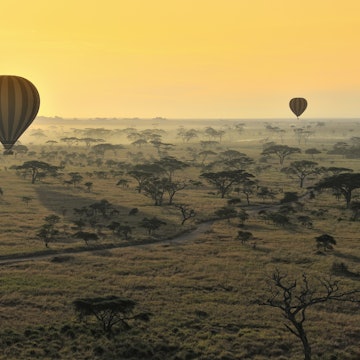

A growing network of paved roads, a new cable car to ancient ruins and a rising number of fine restaurants and hotels have made the northern city of Chachapoyas one of Peru’s fastest growing destinations. Yet its main attraction, the hilltop citadel of Kuélap, still only receives a fraction of the tourists who go to Machu Pichu, which has become so congested that authorities introduced timed entries in 2019.

The Inca may be Peru’s most iconic civilization, but the enigmatic Chachapoya 'cloud warriors' lived a similarly complex existence in the modern-day region of Amazonas with intricate walled settlements and lavish burial chambers for their mummified dead. Here’s a look at how you can help combat overcrowding at the Inca sites near Cusco by instead delving into this lesser-known civilization of the north.

Wander through the ruins of Kuélap
Dubbed ‘the Machu Picchu of the north,’ Kuélap is both older (by more than 500 years) and higher up in the hills (by more than 500m) than its more famous cousin. The Chachapoya crafted near-impenetrable 20m-high limestone walls around this ancient city, with access via three narrow entryways.
Inside are the circular ruins of some 420 stone homes, many with animistic ornamentations depicting snakes and jaguars. Each would have stood at around 4.5m tall with a thatched conical roof. Archeologists believe a population of as many as 300,000 people lived here during the Chachapoya’s apex of power and influence around 1470 before the Inca invaded (but never fully conquered) their northern neighbors.
Long the domain of only the most intrepid tourists, a new cable car line linked Kuélap to the outside world in 2017, easing access to the site and doubling the number of visitors in its first year. The vast majority are Peruvian, but foreigners are beginning to catch on that there’s an impressive and easily accessible citadel in Peru’s emerging northern hills.

Hike to the Revash funerary complex
The cloud forests around Kuélap are home to numerous archeological ruins of the Chachapoya civilization that see even less foot traffic than the iconic fortress. Among the most photogenic is the Revash funerary complex. It was here, around the 14th century, that the Chachapoya took on the improbable task of carving a series of chullpas (ancient Andean funerary towers) out of the side of a limestone cliff and then decorating the surrounding walls with ochre pictographs.
Though the site has long since been looted, archeologists did find a number of skeletons, tools and other artifacts here, as well as in several nearby (and even less accessible) cliff-hugging funerary complexes – all perched 2,800m above sea level. Access to Revash is via a well-marked 2km trail from the potato farming village of San Bartolo, about 80km south of Chachapoyas.

View ancient mummies at Museo Leymebamba
This striking museum in the small town of Leymebamba (85km south of Chachapoyas) contains the world’s best exhibition on the Chachapoya people, who were said to have light skin and green eyes, leading to some wild (and largely disproven) theories that they may have been of European origin (in particular, Celtic).
Displays here include textiles, ceramics and quipu (ancient record-keepers made from strings and knots), as well as a terrifying look at the medical practice of trepanation where holes were drilled into skulls to relieve pressure. Most impressive of all are the mummies. There are 219 of them all clamoring for space in a climate-controlled storage facility located behind a glass wall at the heart of the museum. Many remain wrapped up in funerary bundles, but others have been laid bare and will haunt you for days.

Camp by the mausoleums of Laguna de los Cóndores
A 40km uphill hike from Leymebamba takes you to Laguna de los Cóndores, the high Andean lagoon where the museum’s mummies (and more than 2000 associated artifacts) were first discovered in 1996. Scientists say it was nothing short of a miracle that these mummies survived more than half a millennium in the dark and damp mausoleums in which they were found. Most of the world’s surviving mummies, after all, are found in deserts, not misty cloud forests.
Visitors typically allot three days for the trip here, including one for the arduous hike (or horse ride) up to the forest-encased lagoon, another for sightseeing in the clifftop tombs and a third for the descent. There is a basic hut not far from the ancient Chachapoya settlement where you can overnight in the chilly climes of 2,600m.

Explore the Sarcophagi of Karajía
About 40km northwest of Chachapoyas, near the small town of Cruz Pata, is a short 25-minute hike leading to the human-shaped sarcophagi of Karajía. Little is known about this collection of six 2.5-meter-high sarcophagi, though it’s assumed these burial chambers were reserved for the highest members of Chachapoya society. Each is made from mud, straw and bamboo, with a conical body painted in red and white and a funerary mask over the head. From their perch high up on a cliff face, they stare out over the entire valley.

Experience the living legacy in Chachapoyas
The modern-day city of Chachapoyas (imagine cobblestone streets and whitewashed colonial buildings with red-tiled roofs) is the most logical base for any trip to Peru’s Amazonas region with all the services you’d expect from a budding tourist town. For Amazonas cuisine (bugs and all!) head to El Batan del Tayta, a theatrical restaurant with elaborate plates and ayahuasca-inspired décor. If you want to cleanse your palate after indulging in Caspiroleta de Hormigas (a beverage made with milk, eggs, cinnamon, liquor, and ants) head over to nearby Amazonika; it has a fantastic collection of Peruvian craft beers served at wooden tables in the fairy-lit interior patio.
While Chachapoyas has a solid collection of hostels and guesthouses, more atmospheric lodgings can be found in the surrounding countryside, including the stunning Gocta Andes Lodge (with panoramic views of the towering Gocta Waterfall) and the serene Hotel Casa Hacienda Achamaqui (a colonial-style riverside retreat).
















